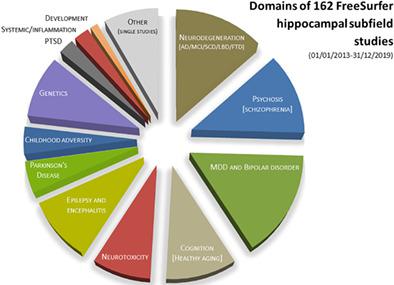当前位置:
X-MOL 学术
›
Hum. Brain Mapp.
›
论文详情
Our official English website, www.x-mol.net, welcomes your
feedback! (Note: you will need to create a separate account there.)
FreeSurfer-based segmentation of hippocampal subfields: A review of methods and applications, with a novel quality control procedure for ENIGMA studies and other collaborative efforts
Human Brain Mapping ( IF 3.5 ) Pub Date : 2020-12-27 , DOI: 10.1002/hbm.25326 Philipp G Sämann 1 , Juan Eugenio Iglesias 2, 3, 4 , Boris Gutman 5 , Dominik Grotegerd 6 , Ramona Leenings 6 , Claas Flint 6, 7 , Udo Dannlowski 6 , Emily K Clarke-Rubright 8, 9 , Rajendra A Morey 8, 9 , Theo G M van Erp 10, 11 , Christopher D Whelan 12 , Laura K M Han 13 , Laura S van Velzen 14, 15 , Bo Cao 16 , Jean C Augustinack 3 , Paul M Thompson 12 , Neda Jahanshad 12 , Lianne Schmaal 14, 15
Human Brain Mapping ( IF 3.5 ) Pub Date : 2020-12-27 , DOI: 10.1002/hbm.25326 Philipp G Sämann 1 , Juan Eugenio Iglesias 2, 3, 4 , Boris Gutman 5 , Dominik Grotegerd 6 , Ramona Leenings 6 , Claas Flint 6, 7 , Udo Dannlowski 6 , Emily K Clarke-Rubright 8, 9 , Rajendra A Morey 8, 9 , Theo G M van Erp 10, 11 , Christopher D Whelan 12 , Laura K M Han 13 , Laura S van Velzen 14, 15 , Bo Cao 16 , Jean C Augustinack 3 , Paul M Thompson 12 , Neda Jahanshad 12 , Lianne Schmaal 14, 15
Affiliation

|
Structural hippocampal abnormalities are common in many neurological and psychiatric disorders, and variation in hippocampal measures is related to cognitive performance and other complex phenotypes such as stress sensitivity. Hippocampal subregions are increasingly studied, as automated algorithms have become available for mapping and volume quantification. In the context of the Enhancing Neuro Imaging Genetics through Meta Analysis Consortium, several Disease Working Groups are using the FreeSurfer software to analyze hippocampal subregion (subfield) volumes in patients with neurological and psychiatric conditions along with data from matched controls. In this overview, we explain the algorithm's principles, summarize measurement reliability studies, and demonstrate two additional aspects (subfield autocorrelation and volume/reliability correlation) with illustrative data. We then explain the rationale for a standardized hippocampal subfield segmentation quality control (QC) procedure for improved pipeline harmonization. To guide researchers to make optimal use of the algorithm, we discuss how global size and age effects can be modeled, how QC steps can be incorporated and how subfields may be aggregated into composite volumes. This discussion is based on a synopsis of 162 published neuroimaging studies (01/2013–12/2019) that applied the FreeSurfer hippocampal subfield segmentation in a broad range of domains including cognition and healthy aging, brain development and neurodegeneration, affective disorders, psychosis, stress regulation, neurotoxicity, epilepsy, inflammatory disease, childhood adversity and posttraumatic stress disorder, and candidate and whole genome (epi-)genetics. Finally, we highlight points where FreeSurfer-based hippocampal subfield studies may be optimized.
中文翻译:

基于 FreeSurfer 的海马亚区分割:方法和应用综述,以及用于 ENIGMA 研究和其他协作工作的新型质量控制程序
海马结构异常在许多神经和精神疾病中很常见,海马测量值的变化与认知能力和其他复杂表型(如压力敏感性)有关。随着自动算法可用于绘图和体积量化,海马亚区域的研究越来越多。在通过元分析联盟增强神经成像遗传学的背景下,几个疾病工作组正在使用 FreeSurfer 软件分析患有神经和精神疾病的患者的海马亚区(亚区)体积以及来自匹配对照的数据。在本概述中,我们解释了算法的原理,总结了测量可靠性研究,并用说明性数据演示两个附加方面(子场自相关和体积/可靠性相关)。然后,我们解释了用于改进管道协调的标准化海马亚区分割质量控制 (QC) 程序的基本原理。为了指导研究人员优化使用该算法,我们讨论了如何对全局大小和年龄效应进行建模、如何合并 QC 步骤以及如何将子字段聚合成复合卷。本讨论基于 162 项已发表的神经影像学研究 (01/2013–12/2019) 的概要,这些研究将 FreeSurfer 海马亚区分割应用于广泛的领域,包括认知和健康衰老、大脑发育和神经退行性变、情感障碍、精神病、压力调节、神经毒性、癫痫、炎症性疾病、儿童逆境和创伤后应激障碍,以及候选和全基因组(表观)遗传学。最后,我们强调了可以优化基于 FreeSurfer 的海马亚场研究的点。
更新日期:2020-12-27
中文翻译:

基于 FreeSurfer 的海马亚区分割:方法和应用综述,以及用于 ENIGMA 研究和其他协作工作的新型质量控制程序
海马结构异常在许多神经和精神疾病中很常见,海马测量值的变化与认知能力和其他复杂表型(如压力敏感性)有关。随着自动算法可用于绘图和体积量化,海马亚区域的研究越来越多。在通过元分析联盟增强神经成像遗传学的背景下,几个疾病工作组正在使用 FreeSurfer 软件分析患有神经和精神疾病的患者的海马亚区(亚区)体积以及来自匹配对照的数据。在本概述中,我们解释了算法的原理,总结了测量可靠性研究,并用说明性数据演示两个附加方面(子场自相关和体积/可靠性相关)。然后,我们解释了用于改进管道协调的标准化海马亚区分割质量控制 (QC) 程序的基本原理。为了指导研究人员优化使用该算法,我们讨论了如何对全局大小和年龄效应进行建模、如何合并 QC 步骤以及如何将子字段聚合成复合卷。本讨论基于 162 项已发表的神经影像学研究 (01/2013–12/2019) 的概要,这些研究将 FreeSurfer 海马亚区分割应用于广泛的领域,包括认知和健康衰老、大脑发育和神经退行性变、情感障碍、精神病、压力调节、神经毒性、癫痫、炎症性疾病、儿童逆境和创伤后应激障碍,以及候选和全基因组(表观)遗传学。最后,我们强调了可以优化基于 FreeSurfer 的海马亚场研究的点。











































 京公网安备 11010802027423号
京公网安备 11010802027423号